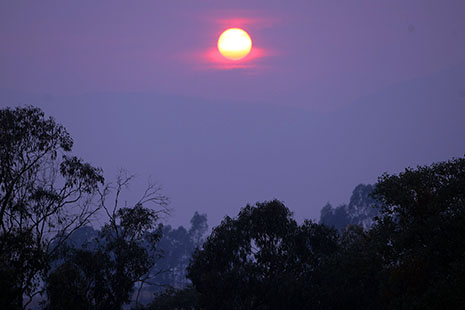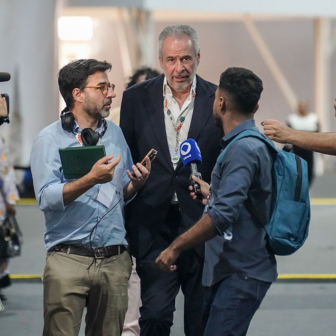WHILE AUSTRALIANS reached deep into their pockets to assist those who have already lost everything, residents of Warburton, Daylesford and Upwey were wondering whether their towns were about to be destroyed and whether they should stay or leave. Victorians are being told to brace themselves for more extreme fire weather. We have March and April immediately ahead of us, and it seems inevitable that this means more bushfire damage. What is to be done?
How should people build their houses? How close should trees be to property? How much should be backburned? Should people stay or should they evacuate? Should every household have a bunker in the backyard? How should destroyed towns be rebuilt? Most of the discussion surrounding the recent horrific bushfires has been focused on prevention, preparedness for response and recovery. It is essential to debate these issues. But there is another component of bushfire management that seems to be missing from public debate and government commitments. We need to be talking about how we fight these fires, how we can get to these fires early and stop them raging out of control. Fires are unlike other “natural” disasters. Whether they originate in sparks from a power tool, a lightning strike, or something more malicious, bushfires start as small fires. This is why early detection and rapid aggressive response is so critical.
Australia is not the only place that has to contend with perfect bushfire conditions. In California, which is three and a half times the area of Victoria, a fleet of aircraft patrols vulnerable areas in time of high fire danger. From bases strategically positioned throughout the state, firefighting aircraft and aircraft containing firefighting ground crews can reach any fire within twenty minutes. From agile helicopters to DC10s, there is a range of firefighting aircraft to suit a range of conditions and there are military aircraft retrofitted specifically to fight fires. There is also a strategy enabling effective coordination between all levels of government and the community in order to fight fires. If a fire proves too big for the California Department of Forestry and Fire Protection to handle, the National Guard, a bit like the Army Reserve here, is called in to help fight the fire. Similarly, the approach of the British Columbia Forest Service in Canada is “Hit Hard and Hit Fast,” with air patrols and thermal imaging technology used to detect fires and map their progression.
We have incredibly brave and selfless individuals fighting the fires, but they are not supported by the communications systems or the technology that would enable them to hit hard and hit fast. Details are murky and will no doubt come out in the royal commission into the Black Saturday fires. But already it seems clear that the fire at Bunyip State forest burned for almost a week before Black Saturday, that the fire which surprised Marysville at about 5pm was first spotted from a fire tower at 3pm, that the first official alert about Kinglake didn’t go out until almost an hour after the fire had arrived there, that spot fires around Kilmore started after that fire had been burning for two and a half hours, and that the only additional resources that Whittlesea Country Fire Authority had to draw on in preparation for the worst fire conditions in recorded Australian history was an extra firetruck.
It is not just people whose homes are surrounded by bush who live with the risk of large-scale destruction from fire. Fortunately, the recent grass fire in Heidelberg was swiftly brought under control, but this fire in drought-stricken, middle-suburban Melbourne was a reminder of the possibility of an urban conflagration, the uncontrolled spread of fire from building to building. While partially fuelled by timber roofing materials, the 1991 urban conflagration in the San Franciscan suburb of Oakland gained momentum from the extreme radiant heat generated by the high density of buildings. This fire destroyed almost 3000 homes.
If a fire breaks out in Victoria, its geographic location determines which firefighting body will have initial responsibility. Victorian forests are under the protection of the state government, and most metropolitan areas are under the protection of the Metropolitan Fire and Emergency Services Board, a fully funded fire service. Other parts of Melbourne and regional properties are under the protection of the Country Fire Authority, which relies on volunteers and donations to function properly. Bushfires do not recognise these administrative borders and the resources needed to stop a bushfire going out of control in extreme weather conditions are beyond the means of any Australian state or territory. As Anthony Bergin rightly points out, uncontrolled fire is a national security issue. As well as taking lives and destroying homes, towns and animals, the recent fires threatened Melbourne’s water supply and power supply. Local knowledge is indispensible when dealing with fire but perhaps we also need a national firefighting service. Certainly we need systems of early warning and rapid response to be coordinated between national, state, and local agencies. And we need appropriate levels of funding for these systems. Some of the $17 billion allocated for defence this year needs to be allocated to defending Australia from uncontrollable bushfires.
It has been argued that the United States has erred too far on the side of wanting to bring all fire under control and, indeed, bushfire is an essential part of the landscape of Australia. But let us be clear-sighted about the distinction between regenerative bushfire and this new breed of raging monster. These forces of destruction are fuelled by the effects of climate change on weather conditions and they can only be brought under control if we can hit them early enough and hard enough. As Wurundjeri elder Joy Murphy said recently, the fires on Black Saturday bore no resemblance to the customary burns conducted by traditional custodians of the land; the fires on Black Saturday were “torture of the land.”
One final point. In 2009, the world has firefighting technology, communications technology and decision support systems far more sophisticated than those used in Australia, to deal with bushfires. These are still insufficient. We can fly people to the moon and destroy cities or individual buildings with speed and precision only because massive amounts of money were injected into research in these areas. We need the vision which was applied to the space race and the political determination which underpins military spending to be applied to learning how to stop bushfire in its tracks. Our people, our towns, our suburbs and our diversity of bush are depending on it. We need to be working towards a future where bushfires raging out of control are a thing of the past. •




